William Sinsky provides us with a tactical analysis of the World Cup quarter final that ended Croatia 2-2 Russia, with the host nation losing out on penalty kicks.
You’d be forgiven if you didn’t expect the hosts Russia to reach the quarterfinals of the 2018 World Cup, yet here they were. After holding off Spain in the Round of 16, the Sbornaya met Croatia at Fisht Olympic Stadium in Sochi, who were looking to advance to the semifinals for the second time in the nation’s history.
Russia had been playing in a 4-5-1 formation for all but one match this tournament. In what was considered an easy group, the defensive setup of a deep block and playing long balls and counter attacks proved successful, as they scored the second-most goals in the group stage with eight, tied with Group G runners-up England. Croatia’s tactics have been more varied on a match by match basis, with manager Zlatko Dalic often switching the formation and personnel.
Lineups:
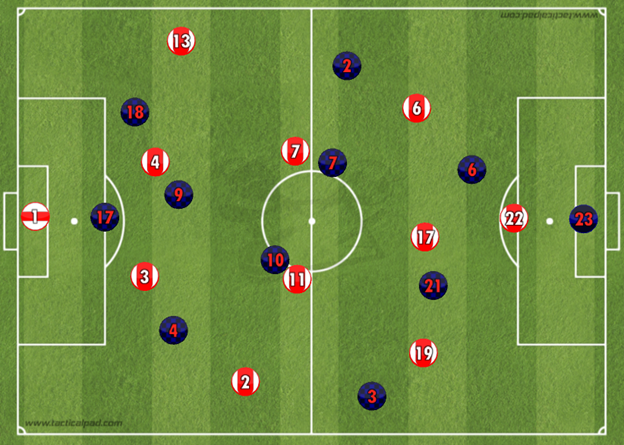
Made using TacticalPad
Russia(4-2-3-1): Akinfeev // Fernandes – Kutepov – Ignashevich – Kudryashov // Zobnin – Kuzyaev // Samedov – Golovin – Cheryshev // Dzyuba
Croatia(4-2-3-1): Subasic // Vrsaljko – Lovren – Vida – Strinic // Rakitic – Modric // Rebic – Kramairic – Perisic // Mandzukic
Russia came out in a 4-2-3-1, which shifted to a 4-4-2 for most of the match with Aleksandr Golovin moving up next to Artem Dzyuba and Aleksandr Samedov and Denis Cheryshev playing the wings. The single striker formation was used primarily in possession, as right back Mario Fernandes was often the start of Russia’s attacks, and tucking the midfielders in would give him space to work down the right side.
Croatia also played a 4-2-3-1, with key midfielders Ivan Rakitic and Luka Modric playing the double pivots. Andrej Kramaric played underneath Mario Mandzukic, and often stayed high closer to the striker. Croatia also attempted to play the ball out wide, but for a different reason; to try and move around Russia’s 4-4 deep block.
Russia Start Out Strong
With the hope of scoring early and a large home crowd behind them, Russia began the match with a more confident approach, attempting to find space down the wings due to Croatia’s strong midfield. One such attack occurred in the 2nd minute. As Domagoj Vida pushed forward in possession, an interception by Roman Zobnin initiated a counter-attack down the right flank. Golovin passed the ball to Dzyuba, who, with Vida further down the pitch, passed it to Cheryshev who was making a run into the space Vida would normally occupy. Fortunately for Croatia, right back Sime Vrsaljko managed to pressure Cheryshev enough to force a goal kick. Russia made a few more attempts to press and counter early, but Croatia’s defenders managed to stifle them via clearances and blocks.
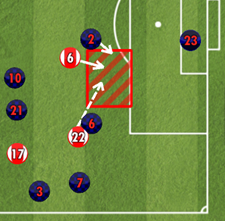
2nd minute
For a majority of the match however, Russia focused on defending in a deep block by playing a 4-4-2 formation, with Dzyuba and Golovin as the forwards who occasionally pressed once Croatia moved into their half. Russia was okay with staying deep and hitting long balls forward in attempts to begin counter attacks as long as it halted Modric’s build up play through the middle. To get around this, Croatia tried to release their wingers and full backs down the sides and get them to cross the ball into the box to target man Mandzukic. However even this proved difficult as Russia’s structure remained strong, rarely resulting in any overloads on the flanks.
The Role of Ivan Rakitic
Another reason Croatia struggled to get anything going offensively was due to the role Rakitic played. When Croatia couldn’t find any space between Russia’s defense, the ball would be cycled back through the defense in a switch of play. In these instances, Rakitic fell back between the center backs, acting as a general by, once receiving the ball, deciding whether to play it up the middle to Modric or continue to shift the attack to the opposite side of the pitch. This drop forced Modric himself to drop back to receive the ball, and with Kramaric staying up near Mandzukic, the highly organized Russian front blocked Modric from progressing forward this way. There were a few times when he did manage to dribble down the half spaces successfully, but they often resulted in clearances or intercepted passes.
Russia’s First Goal
The opening goal occurred in one of the few instances when Rakitic moved beyond the back line. Cheryshev brought the ball down after a long ball from Igor Akinfeev. Rakitic moved forward to press him, so Cheryshev passed the ball up to Dzyuba. Rakitic then moved back to press Dzyuba, leaving Modric, who was in a static position, to chase down Cheryshev who was in mid-sprint. The one-two ball was played, the Russian winger ran around Modric, who’s desperation tackle was unsuccessful, moved the ball onto his left side with one touch and unleashed a powerful shot into the top left corner from just outside the box, leaving Danijel Subasic still standing. The new Villarreal man had scored his fourth goal of the tournament, and Russia were on the front foot.
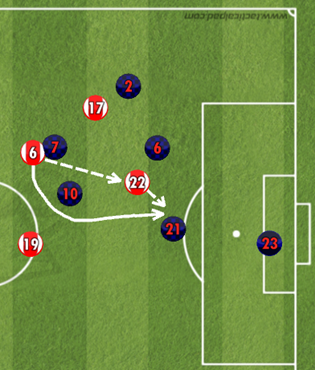
31st minute
The opening goal gave Russia a boost of confidence as Croatia felt flustered. The home side continued attacks through the likes of Fernandes and Golovin. The Brazilian-born defender specifically pushed so far forward that he was often the second-furthest Russian on the pitch, whipping in crosses beside Croatia’s box. Fernandes plays as a right-wing back at his club CSKA Moscow, so this was an effective style of play for him.
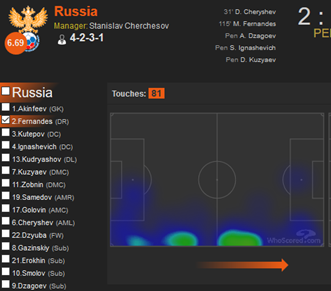
Despite the gain of confidence for Russia, Croatia scored about seven minutes later on a cross from Mandzukic to Kramaric in which Russia’s defenders were caught ball-watching. The first half was largely a disheveled Croatia attempting to break through a compact Russian defense.
The Role of Luka Modric
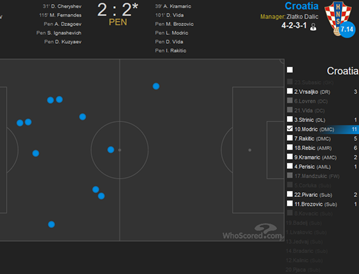
The starts of Modric’s dribbles were largely down the half spaces
For the second half, Croatia, specifically Modric, began a more direct style of play. Modric was the focal point of any attack, and due to the way Croatia built up possession it relied on his renowned creativity. In attempts to free up space along the wings, Modric began to dribble with pace down the half spaces, pulling defenders in so he could release the outside man to put in a cross. This was reinforced by the substitution of Perisic for Brozovic; a deeper-playing midfielder who could receive the ball from the back line, therefore giving Modric the freedom to progress forward, where he is best, and send the ball up to Mandzukic and Kramaric. To combat this, Russia moved Golovin back to shade Modric with Zobnin or Kuzyaev, depending on the half space Modric moves into. This worked at times, though the Croatian still managed to dribble multiple times into or near Russia’s box.
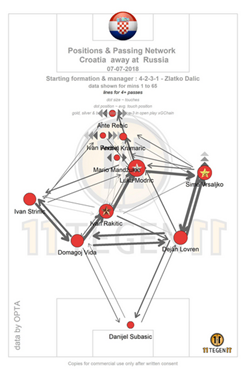
One of these such runs eventually led to Croatia’s go-ahead goal late in extra time. With Rakitic, Vida, and substitute Mateo Kovacic pushed forward, Modric received a back pass from Vida into the right half space. He then dribbled towards Russia’s box, played the return pass to Vida, who played the ball out for a corner. It would be those two connecting again on the ensuing corner kick, this time with Modric’s cross reaching the head of Vida.
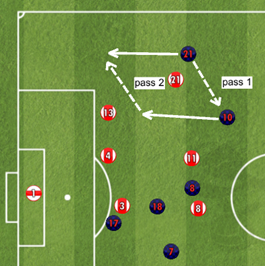
100th minute
With the lead and about twenty minutes remaining, Croatia switched to defending deep. Modric showed his defensive prowess in assisting presses with Russia playing into their half. Despite the constant energy from the Real Madrid midfielder, Russia managed to find an equalizer through a free kick by substitute Alan Dzagoev that was headed in by none other than Mario Fernandes. The match went to penalties, which threw a cruel twist of fate into Fernandes’ tale. His shot from the spot went wide, and moments later the shot from Rakitic hit the back of the net, resulting in Croatia’s advancement to the semifinals.
Conclusion
Despite the loss, Russia can hold their heads up high. The host nation headed into the tournament with overall low expectations and exceeded them confidently, playing their tactics through to the end.
For Croatia, the golden generation has also reached further than many expected. If the Vatreni do manage to reach or even win the World Cup Final, it will undoubtedly be through the feet of talisman Luka Modric, who was without a doubt the bright spot in Croatia’s unconvincing yet affirming quarterfinal victory.
Read all our tactical analyses here.
- Tactical Analysis: Croatia 2-2 Russia | Modric and Rakitic make the difference - July 10, 2018
- U17 World Cup 2017: Team of the Tournament - November 1, 2017
- U17 World Cup 2017 Tactical Player Report: Spain 3-1 Iran - October 28, 2017
























































